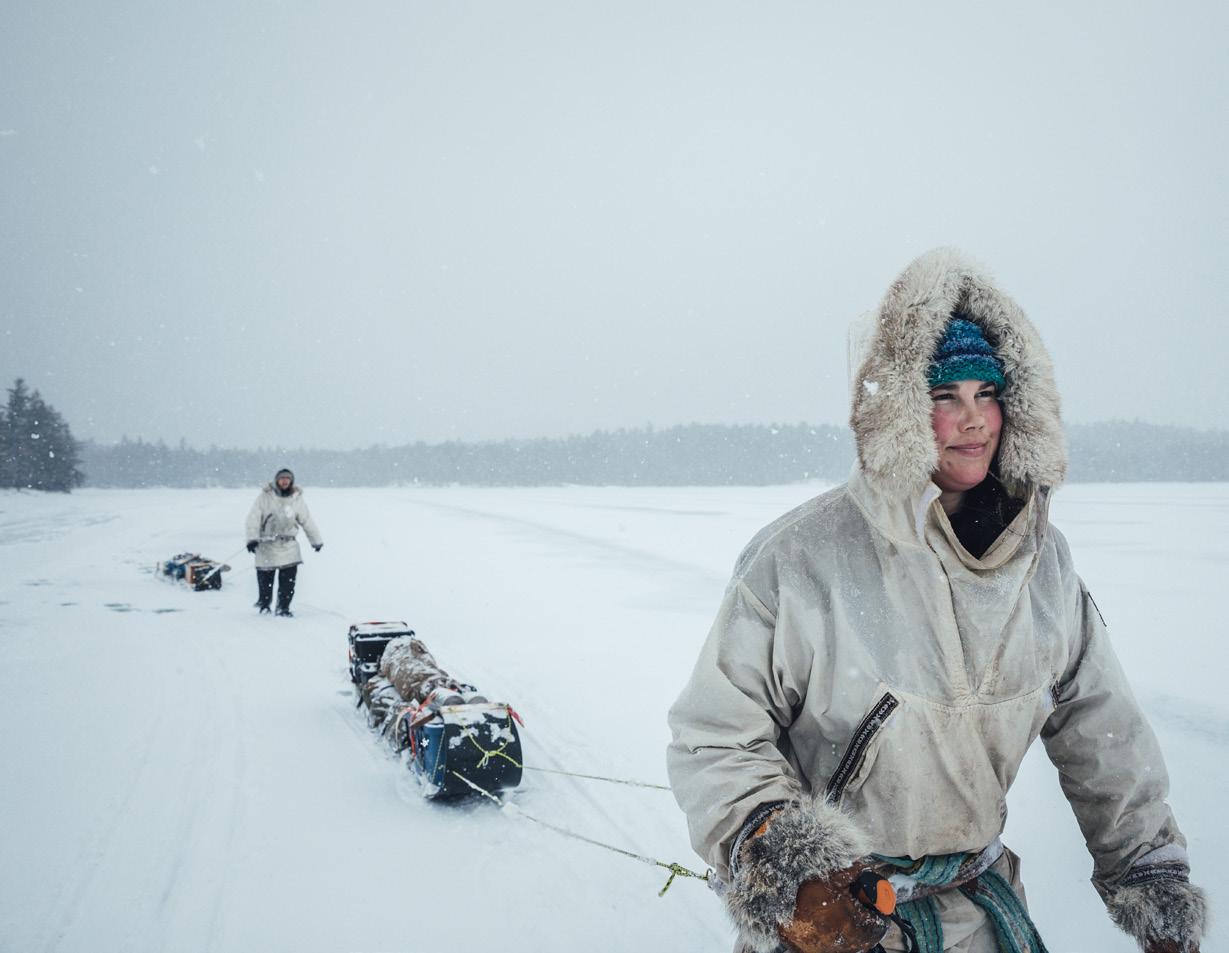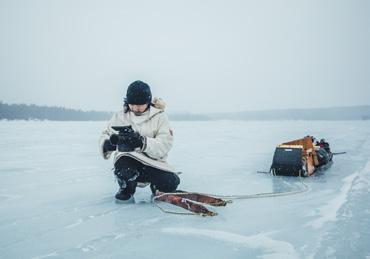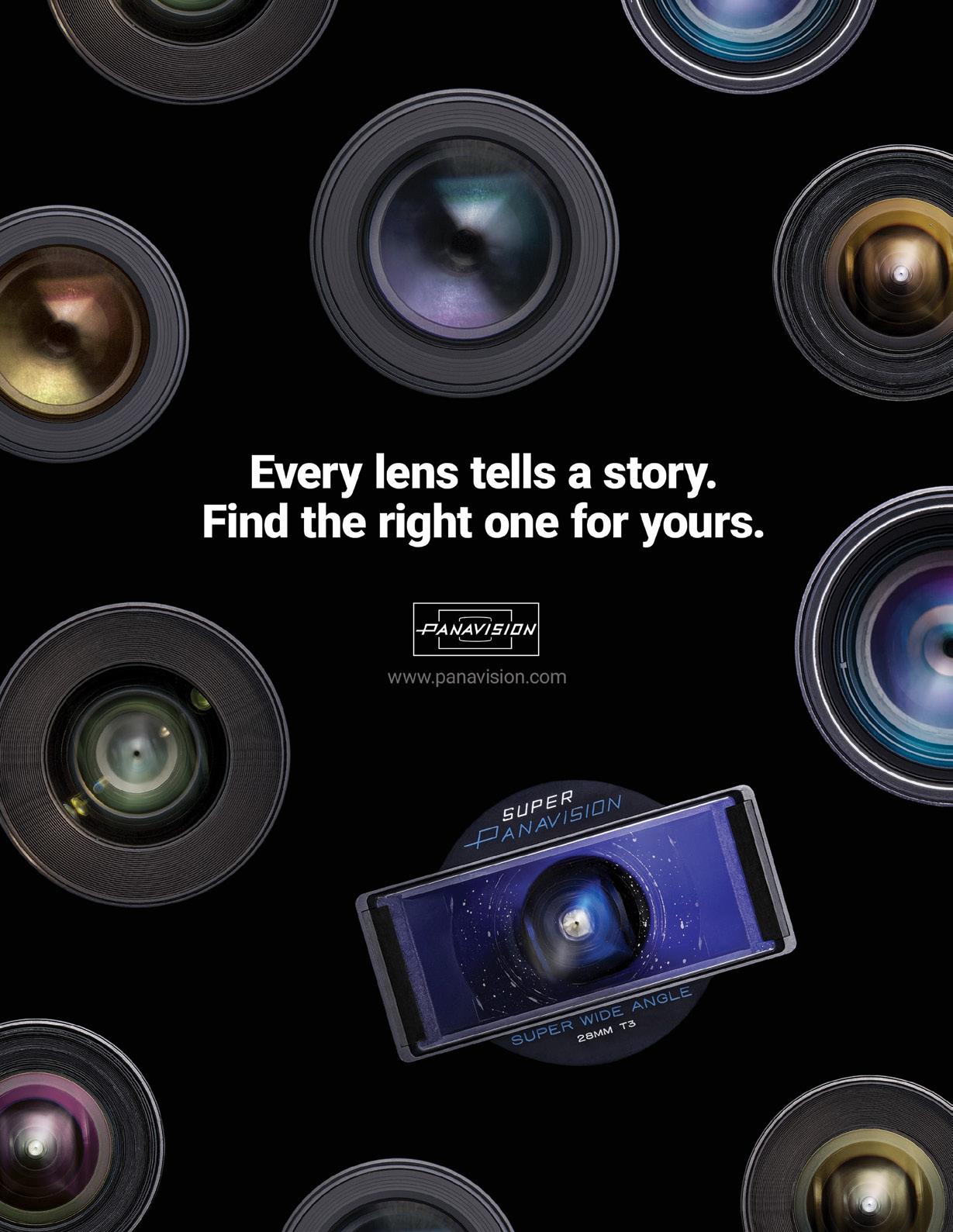
11 minute read
Lure of the North
By Goh Iromoto
Drior to this project, I’d done another short film called Pull up in Vermillion Bay and a number of commercial campaigns photographing in Northern Ontario. I learned the important art of layering and how much of a difference wind can make in lowering temperatures out on open frozen lakes. These commercial projects were how I initially met Dave and Kielyn Marrone, the couple featured in Lure of the North who live off the grid year-round. I shot the film in two parts. I was admittedly inspired after watching The Revenant back in 2016 and wanted to capture an essence of that film but with real people. So we filmed for three to four days in March of that year using Dave and Kielyn Marrone’s property near Espanola, Ontario, as our base camp. The property is 40 acres with thousands of acres of crown land surrounding it. Some of the shooting we did that first time was on crown land. As I do with many of my personal projects that I both direct and shoot, my wife Courtney supported me, recording sound, prepping my gear, drone and gimbal, and all
the other tasks needed to make the shoot happen. We luckily had the help of a friend who would drive us around on a snowmobile to get some of the smooth tracking shots you see in the film. We came back home with some beautiful footage, but I felt that there was something missing, something that felt more authentic to the actual experience of a winter expedition. Because we had essentially staged all our scenarios, there was an element of truth that was missing. The main look and feel I was trying to achieve was one I describe as cinematic realism. It’s one of beauty that would showcase the landscape and the people with a sense of elevation but also intertwined with a sense of something raw and real. So in February 2017, we decided to embark on an actual expedition together for eight days up in Temagami, Ontario. We had a much smaller handheld kit. No gimbals or anything that would bog us down. Lots of batteries. A small mobile media managing kit and a Mavic Pro for aerial shots. Inevitably, all our tracking shots were shaky. Snow or wet ice splashing on the lens was constant. And the frustrating effect of lens condensation when going in and out of warm tents was a constant battle. But all of these moments ended up being used in our film, because it was just so much more representative of how this experience feels. We started off in bone-chilling temperatures with crisp mornings and having to chip away frost off the bottom of our sleds. But then we also had days where the temperatures rose creating beautiful atmospheric fog, and even slush which made pulling toboggans quite difficult. I recall one day where it took us the entire day to travel a mere 2km! I ended up doing quite a lot of prep and testing for this shoot. For the first phase in 2016, I was relatively new to operating a gimbal, so I did plenty of tests both in nature and with a subject. The main goal was to achieve something of my own vision having been inspired by Chivo’s [Emmanuel Lubezki ASC, AMC] work in The Revenant. For 2017, the biggest challenge was trying to pare down the essential gear for the eight-day expedition. We each had to pull a traditional expedition-style toboggan. These often weigh around 300lbs+ each once layered with all of our winter gear, camping gear, food, tools for winter (ice pick, saws, axes, stoves, etc.) and camera gear. The other challenge was that they’re designed so that the only accessible area during travel is a small box about 14” x 14” at the very front. Normally this is where snacks, water and extra gloves or layers would go, but in my case, I had to use it for packing my camera and extra batteries. It forced me to strip the camera down to its essentials, simply so it could fit and be efficient when filming. Like most documentary-style scenarios, it was more of a priority to have a camera that could be available and efficient, rather than a camera that was perfect and fully loaded. Being a self-funded project, I chose the RED Dragon in 2016 and the RED Helium 8K in 2017 mainly because it was the camera I owned. I definitely also had more confidence in the RED system for being able to pull through extreme conditions. In terms of lenses, I mainly shot this piece using the Sigma 18-35 mm f1.8 art lens. I needed something that was light, small, had the range I was looking for, could be used in low light, and had a beautiful aesthetic quality that worked with the feel I was going for. There were a number of
3
Credit: Courtney Iromoto Main photo: Dave (left) and Kielyn Marrone during the production of Lure of the North.






Left photos: Dave and Kielyn Marrone in Lure of the North Above: Goh Iromoto csc filming Kielyn Marrone and out on a lake during production.
challenges on this shoot. Two to three of my batteries completely died due to condensation buildup. Also lens condensation – I had used all my previous tricks, including wrapping lenses in tight plastic, but it was just inevitable in most cases. The worst was when it built in between the elements and you couldn’t do anything about it but wait or shoot with it. Everything else held up great. Filming in cold conditions, for me, has similarities to filming underwater. It’s easy enough to assume that if you can operate a camera, that it shouldn’t be so different. But being able to operate normally while in different conditions and attire is another thing. Make sure that you spend an equal amount of time preparing for your clothing. You want to be able to move smoothly, freely and comfortably, and yet stay warm. You want to layer when temperatures warm up or get cold all of a sudden. And you want to even practice operating with all of these layers on, including snowshoes if that will be part of your attire. It’s different to normal operating so it’s worth spending the time and energy preparing.



New Zeiss Supreme Making A Mark
There are few lens manufacturers who can hold a candle to Carl Zeiss when it comes to quality, consistency and reliability. So when the marquee rolled out the latest in their Supreme Prime series last summer, more people have been checking out this lineup of 14 lenses – with the final lens in the set, a 15 mm T 1.8 prime, set to launch soon – to see how it compares with the Zeiss Masters both in look and digital capability. Calgary-based director of photography Craig Wrobleski csc, who used them while shooting Shrine in Boston last fall, has his own humorous take: “It’s like the Zeiss Masters and Cooke S4s had a one-night stand and this is the result.” Sure, it’s tongue-in-cheek, but it aptly and succinctly describes the end result of the new lens line. The sharpness is still there across the frame, but there’s a more subtle and gentle roll-off so it isn’t as clinical as previous lines. “It is a different look and I think this shows that Zeiss is talking and listening to DPs,” says Ron Steinberg, Sr. Product Manager at Gentec International’s Professional Imaging Group, which handles the brand in Canada. “With the focus roll-off, there’s an extremely delicate skin tone; it’s not harsh at all.” Initially in 2018, Zeiss released the (all T1.5) 25 mm, 29 mm, 35 mm, 50 mm and 85 mm lenses, and has since added 18 mm, 21 mm, 100 mm, 135 mm, 150 mm (T1.8) and 200 mm (T2.2). The 15 mm will also be T1.8. The other difference is they’re compact and light but still maintain the Zeiss robustness. Want warmer still? There’s a parallel series of Prime Radiance, which offers seven lenses with a still warmer cast and controlled flares for large-format coverage. The Supreme line also captured the Netflix series The Queen’s Gambit with its stunning retro-glam couture and 1960s interiors shot partially in Cambridge, Ontario, by DP Steven Meizler on a RED MONSTRO. When it came to the Supremes, it was the form factor that attracted Wrobleski, who employed the initial release two years ago on In the Tall Grass. As cameras continue to shrink in size and weight, the lighter glass makes for a more balanced package, a bonus when shooting handheld or with gimbals, as he explains. “Zeiss is dependable glass, but I’ve sometimes missed the character of a Cooke,” Wrobleski says. “And the other thing, especially
New Zeiss Supreme Making A Mark
shooting In the Tall Grass, was the form factor. We tested a bunch of lenses, shooting with the original LS, not the Mini, which was brand new at the time, and it’s a sizeable camera. I needed a lens that wasn’t going to add more bulk. We looked at the Cooke S7, but with the LF, it made a beast of a camera; the whole film took place in grass, and we knew we’d be using Steadicam and gimbals a lot. The Cookes were beautiful, but they were as heavy as the camera. When I cracked the case on the Supremes, never having seen them, I was blown away.” The result, which Wrobleski describes as a “rounder image,” was also a pleasant surprise, while the extended metadata also proved useful. He used the Supremes more recently on Shrine, a Sony Pictures project shot on the VENICE that required a lot of VFX, and so the lens data was invaluable. “They’ve been very reliable, having shot them on three projects now, winter cold, summer heat,” he says. “In the Tall Grass was a punishing project on gear. Middle of an Ontario summer, a hot field, humid with bugs, dust and rain.” The lenses themselves are extremely sharp, Steinberg says, and the tagline is “gentle sharpness,” but make no mistake, Zeiss aren’t going soft on anything. “The difference is that when the Master Prime snaps into focus, it’s razor-sharp but in going out of focus it drops off immediately, which is kind of harsh,” he says. “With the Supremes, they’ve controlled how the focus rolls off. It falls off nice and delicately, so you have this great skin tone; it’s gentle but not harsh when capturing a face portrait, for example.” According to Steinberg, word has gotten around and the lenses have been shot on a series of projects including The Umbrella Academy (Season Two), Locke & Key, Designated Survivor (Season Four), and In the Tall Grass, married to a range of full-format cameras including the ARRI LS, RED MONSTRO, Sony VENICE and the ALEXA 65 in 5K mode. There are also a few other technology upgrades built into the series because, like everything in the cinematography world, lenses have also seen their role impacted by demand for digital data. The Supremes come with the standard metadata of Cooke’s /i technology and goes a couple of steps further, layering on their Zeiss eXtended Data (XD), which considerably speeds up data correction since it can be done in post with a couple of clicks rather than manually. Steinberg says there are some palpable benefits from the eXtended Data, which captures focus distance, f-stop and can calculate depth of field per frame. The Zeiss eXtended system adds two components, lens shaping and distortion to a resolution of one millimetre. This becomes useful when using green screens, for example, he says, since the computer has no distortion. However, with the metadata, any of the two images can be melded as one, incorporating the data for a seamless blend. “Before, to do this you had to send the assistant to the rental shop and shoot a grid with every lens at every stop to capture the distortion,” he says, but it still resulted in some estimations. The eXtended data gives perfect information and eliminates the time-consuming process of having to manually record the characteristics of each lens, not to mention cutting the cost of both the assistant and the rental house. In the event a scene has to be re-shot, matching up the lens is made easier by the metadata captured and recorded, he adds, right down to the serial number. It’s playing into Netflix’s production machine because that data might speed up and make workflows more efficient, which in turn cuts costs as the understanding of how to apply it evolves.
Ian Harvey is a journalist who has been writing about digital disruption for 20 years. He welcomes feedback and eagerly solicits subject matter ideas at ian@pitbullmedia.ca.







